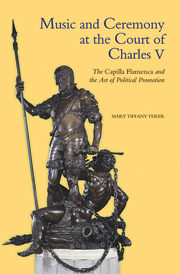 Music and Ceremony at the Court of Charles V
Music and Ceremony at the Court of Charles V Book contents
- Frontmatter
- Contents
- List of Illustrations
- List of Tables
- Preface and Acknowledgements
- List of Abbreviations
- Dedication
- Chapter 1 Charles V: Defender of the Faith and Universal Monarch
- Chapter 2 The Genesis of the Chapel
- Chapter 3 The Reconstruction of the Capilla Flamenca
- Chapter 4 The Chapel Ordinances: Ritual and Repertory at the Court
- Chapter 5 Music and Ceremony at the Court of Charles V
- Chapter 6 Charles V as Crusader and Christian Knight
- Chapter 7 The Presentation of the Emperor
- APPENDIX A Chapel Rosters
- APPENDIX B Chapel Statutes and Ordinances
- APPENDIX C Selected Chapel Personnel
- APPENDIX D Musical Manuscripts, Prints, and Editions
- Glossary
- Bibliography
- Index
Chapter 4 - The Chapel Ordinances: Ritual and Repertory at the Court
Published online by Cambridge University Press: 05 October 2013
- Frontmatter
- Contents
- List of Illustrations
- List of Tables
- Preface and Acknowledgements
- List of Abbreviations
- Dedication
- Chapter 1 Charles V: Defender of the Faith and Universal Monarch
- Chapter 2 The Genesis of the Chapel
- Chapter 3 The Reconstruction of the Capilla Flamenca
- Chapter 4 The Chapel Ordinances: Ritual and Repertory at the Court
- Chapter 5 Music and Ceremony at the Court of Charles V
- Chapter 6 Charles V as Crusader and Christian Knight
- Chapter 7 The Presentation of the Emperor
- APPENDIX A Chapel Rosters
- APPENDIX B Chapel Statutes and Ordinances
- APPENDIX C Selected Chapel Personnel
- APPENDIX D Musical Manuscripts, Prints, and Editions
- Glossary
- Bibliography
- Index
Summary
On 25 October 1555, during a ceremony in Brussels, Charles V, Emperor of the Holy Roman Empire and King of Spain, transferred his rule in the Netherlands to his son Prince Philip. In the abdication speech which followed, Charles recounted that during his reign of over 40 years, he had made 40 journeys: ten trips to the Low Countries, nine to Germany, seven to Italy, six to Spain, four to France, two to England, and two to North Africa. He recalled that he had made 11 voyages by sea, and would soon make a final one to Spain. As he put it, ‘my … life has been one long journey’.
At the height of his reign Charles ruled over almost 28 million people, 40 per cent of the population of Europe. It has been said that his was ‘an empire on which the sun never set’, and ‘that stretched over the surface of half the known world’. To administer this vast empire necessitated frequent travel, and, as we noted in Chapter 1, it has been estimated that he spent approximately a quarter of the period 1517 to 1555 on the road. As Charles travelled, he left regents, often members of the royal family, in charge. Governance conducted by correspondence was hampered both by the time lapse in communication between such widely dispersed territories and by his reluctance to relinquish decision-making to others.
- Type
- Chapter
- Information
- Music and Ceremony at the Court of Charles VThe Capilla Flamenca and the Art of Political Promotion, pp. 126 - 159Publisher: Boydell & BrewerPrint publication year: 2012


